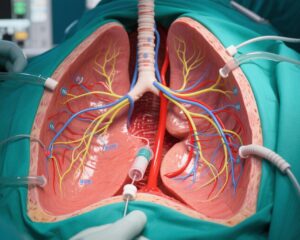Highlight
1. This phase 3 randomized clinical trial compared induction-concurrent chemotherapy versus concurrent-adjuvant chemotherapy in patients with high-risk N2 to N3 nasopharyngeal carcinoma.
2. No significant difference in 3-year progression-free survival was observed between the two treatment sequences.
3. Both treatment strategies had manageable but distinct toxicity profiles, with treatment-related deaths occurring only in the induction-concurrent group.
4. The findings support personalized treatment discussions balancing efficacy and safety for advanced nasopharyngeal carcinoma patients.
Study Background and Disease Burden
Nasopharyngeal carcinoma (NPC) is a distinct malignancy arising from the nasopharyngeal epithelium, with a high prevalence in Southeast Asia and southern China. Locoregionally advanced NPC, particularly stages with high nodal burden such as N2 to N3, confer a significant risk of disease recurrence and distant metastasis. The Epstein-Barr virus (EBV) DNA level in plasma is a robust biomarker for tumor burden and prognosis, and a pretreatment level ≥1500 copies/mL identifies high-risk patients who require intensified therapy approaches.
The standard of care for such patients includes chemoradiotherapy, but the optimal sequencing of chemotherapy—whether induction (before radiation) or adjuvant (after radiation)—remains uncertain. Induction chemotherapy aims to reduce tumor bulk and micrometastatic disease early, potentially improving distant control; adjuvant chemotherapy targets residual disease post-radiotherapy. Previous studies have shown benefits with both strategies but lacked head-to-head comparisons in homogeneous high-risk populations defined by nodal status and EBV DNA load.
Study Design
This open-label, randomized, phase 3 clinical trial was conducted at Sun Yat-sen University Cancer Center in China between November 2017 and March 2021. Eligible patients were aged 18 to 65 years, diagnosed with stage T1-4N2-3M0 NPC, and demonstrated EBV DNA levels ≥1500 copies/mL before treatment initiation.
Participants were randomized to either:
(1) Induction-Concurrent group: three cycles of induction chemotherapy comprising paclitaxel, cisplatin, and fluorouracil followed by concurrent chemoradiotherapy;
(2) Concurrent-Adjuvant group: concurrent chemoradiotherapy followed by three cycles of cisplatin-fluorouracil adjuvant chemotherapy.
The primary endpoint was 3-year progression-free survival (PFS), defined as time from randomization to local/regional recurrence, distant metastasis, or death from any cause. Secondary outcomes included overall survival, pattern of relapse, and toxicity profiles.
Key Findings
A total of 324 patients were enrolled and evenly assigned to the two groups (162 per arm). The median age was around 44–45 years, with a median follow-up duration exceeding five years (60.4 months).
The 3-year PFS rates were 73.5% (95% confidence interval [CI], 65.9%–79.6%) in the induction-concurrent group and 70.4% (95% CI, 62.7%–76.8%) in the concurrent-adjuvant group, corresponding to a stratified hazard ratio of 0.86 (95% CI, 0.58–1.27; P = 0.45). This indicates no statistically significant difference in progression-free survival between the two chemotherapy sequencing strategies.
Regarding safety, the most common grade 3 or worse acute toxicities in both groups were leukopenia (33.1% in both groups), neutropenia (32.5% vs 22.5%, induction-concurrent vs concurrent-adjuvant), and mucositis (approx. 29% in both groups). Late grade 3 or worse adverse events included auditory or hearing loss (6.3% vs 8.5%, respectively). Importantly, two treatment-related deaths occurred in the induction-concurrent group, whereas none were reported in the concurrent-adjuvant group.
Other findings indicated both regimens were effective in disease control but showed differences in hematologic toxicities and treatment-related mortality risk. The data further highlight the necessity for vigilant toxicity monitoring and individualized patient management.
Expert Commentary
This trial provides pivotal evidence addressing a long-standing clinical question in treating high-risk N2 to N3 NPC. The absence of a significant difference in progression-free survival suggests that both induction and adjuvant chemotherapy sequences are viable options, allowing treatment choices to factor in patient preference, comorbidities, and toxicity risk.
While induction chemotherapy may theoretically improve distant control by eradicating micrometastases upfront, this trial did not demonstrate a clear survival advantage over concurrent chemoradiotherapy followed by adjuvant chemotherapy. These results align with emerging perspectives emphasizing the comparable effectiveness of these strategies in carefully selected patient cohorts.
Notably, the increased incidence of neutropenia and treatment-related deaths with induction chemotherapy underscores the importance of assessing hematologic reserve and incorporating supportive care measures. Clinicians should weigh the potential benefits against toxicity risks, discussing these aspects transparently with patients.
Limitations of the trial include its single-center design and patient population restricted to a specific demographic, possibly affecting global generalizability. Additionally, long-term quality of life outcomes and compliance metrics merit further investigation. Future research might also explore molecular and immunological markers to better tailor chemotherapy sequencing in NPC.
Conclusion
This phase 3 randomized trial demonstrated that induction-concurrent chemotherapy did not significantly improve progression-free survival compared to concurrent chemoradiotherapy followed by adjuvant chemotherapy in patients with high-risk N2 to N3 nasopharyngeal carcinoma. Both regimens showed efficacy with differing toxicity profiles. Personalized therapeutic decisions incorporating individual patient risk factors, tolerability, and preferences are essential to optimize outcomes in this aggressive disease subset.
Ongoing studies and longer follow-ups are warranted to refine chemotherapy sequencing and integrate novel systemic and targeted therapies to further improve survival and quality of life in nasopharyngeal carcinoma.
References
Guo SS, Li XY, Liu LT, Jia GD, Liu SL, Sun XS, et al. Induction vs Adjuvant Chemoradiotherapy in Patients With High-Risk N2 to N3 Nasopharyngeal Carcinoma: A Phase 3 Randomized Clinical Trial. JAMA Oncol. 2025 Aug 1;11(8):864-873. doi:10.1001/jamaoncol.2025.1597. PMID: 40531520; PMCID: PMC12177731.
Chan ATC, Gregoire V, Lefebvre JL, et al. Nasopharyngeal carcinoma. Nat Rev Dis Primers. 2019;5(1):30. doi:10.1038/s41572-019-0060-9
Chen L, Hu CS, Chen XZ, et al. Concurrent chemoradiotherapy plus adjuvant chemotherapy versus concurrent chemoradiotherapy alone in patients with locoregionally advanced nasopharyngeal carcinoma: a phase 3 multicentre randomized controlled trial. Lancet Oncol. 2012;13(2):163-171. doi:10.1016/S1470-2045(11)70320-4

